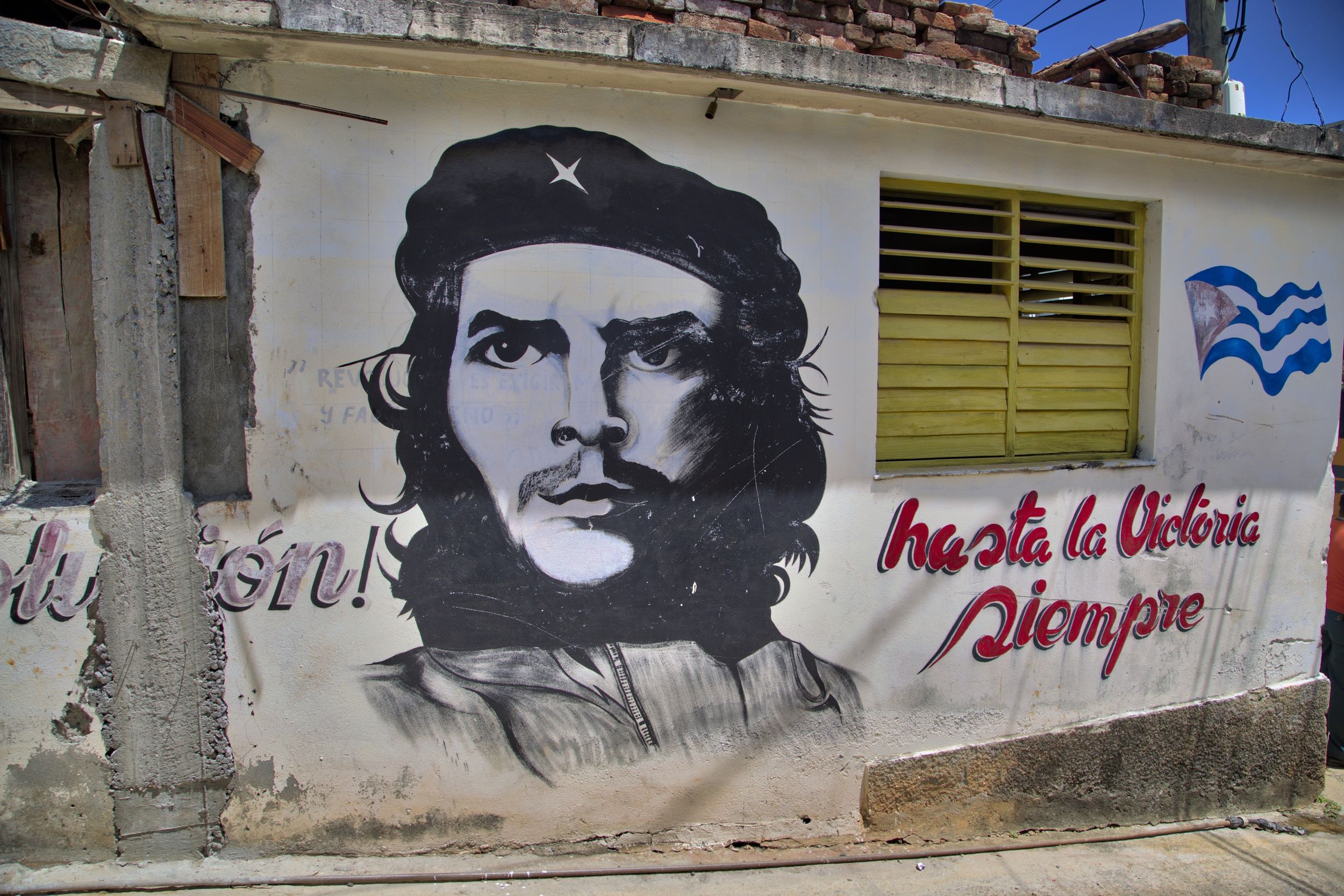So you’ve just arrived, somewhat exhausted, into Cuba’s international airport in Havana. It’s been a long trip from Sydney and it’s your first visit to the Caribbean nation, so everything seems strange – exotic even. It’s hot, the air conditioning in the airport isn’t working, and your bags are somewhere in the building but not, as you were hoping, on the carousel waiting for collection before heading into the city.
The first lesson any visitor needs to learn as they arrive into Havana is patience. Thanks to nearly 60 years of economic and political isolation, Cuba is starved of most resources, technology, and income, so despite some signs that the economy might be improving, expect delays, hotel double-bookings, food shortages, a general lack of basic amenities, unreliable Internet access, equipment breakdowns, and mild pandemonium that we’d never tolerate in a first-world country such as Australia.
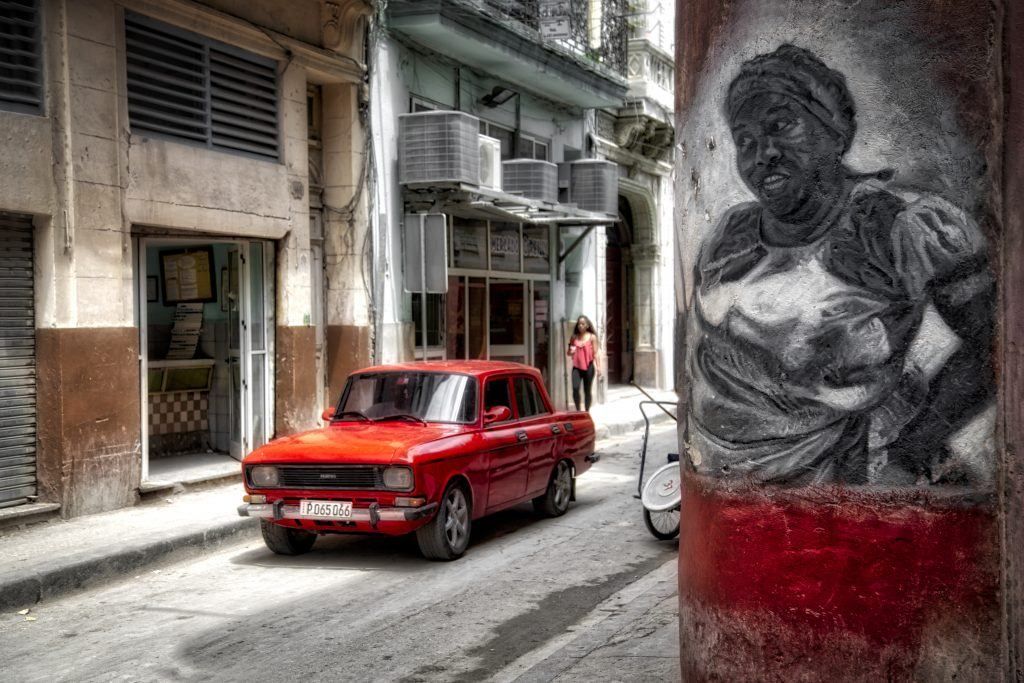
Wall art features highly all over Cuba. Most of it is political, but there’s also a lot of fun stuff put up by locals that can be included in a composition to add color or interest to an otherwise rather drab street scene. Photo by Robin Nichols
Providing you take this in your stride, none of this apparent chaos need impact your enjoyment. On one visit I checked into the beautiful Art Nouveau Hotel Raquel in the old city for four nights. The room was on the top floor. On day two the lift broke down and it was a real hassle to walk up four floors twice or three times every day. We quickly got fed up with the effort and went looking for the service elevator – which, of course, worked perfectly. No one in the hotel was going to share that bit of information with the guests; neither did anyone have an idea of when the main lift was going to be fixed. Fifty years of socialism, where much of your daily needs like employment, education, medicine, and even food staples are provided by the State, have produced an apathy that’s common in other Communist countries. You just have to accept that this is mostly how things work. Or don’t, as the case may be.
In the last few years the regime has relaxed some of its regulations, enabling those locals with ambition to run their own businesses, like bars, restaurants, cafés, or souvenir shops selling t-shirts of Castro and Che Guevara, so things are improving. But as we all know, much of the country’s future depends on how relations with the USA proceed.
What you’ll learn from this guide:
- Outline of the best gear to take
- Scams to be wary of
- How to approach locals to get a shot
- Working with the high dynamic range (HDR) technique
- Accessories that are useful to pack
- Night shooting suggestions
- How to simplify a busy picture using the Scene Cleaner in Elements
- Data backup options
- How to shoot panoramas, indoors and out
Recommended Reading: Want to improve your travel photographs? Grab a copy of Photzy’s bestselling premium guide, Powerful Imagery, by award-winning photographer Mitchell Kanashkevich.
1. Experiment Bracketing Your Exposure for HDR
As you approach the old city fronting the Malecon (Havana’s long harbor-front esplanade), you’ll see more beautiful old Spanish colonial buildings, some in desperate need of repair, while others sit resplendent in their new role as a tourist hotel or restaurant. Whenever I see this I can’t help but think of shooting in high dynamic range, or HDR, mode.
Shooting multiple exposures of the same subject and then post-processing them together using specialist HDR software (such as Photomatix Pro, Photoshop, or Aurora HDR Pro) produces not only a range of tones that a single shot, in contrasting light, often cannot capture, but it also helps exaggerate the grunginess of the subject texture. It’s a look that not everyone might like, but in the narrow streets of Old Havana, even mildly processed HDR photographs can produce an impressive result. I use the camera’s exposure bracketing to make three different exposures (usually set to one stop lighter, one normal exposure, and one darker). Naturally, the faster the drive mode is, the better your chances of getting the three frames to line up – but the software is also good at lining frames up precisely if you are not a steady shooter. You can also make an acceptable HDR effect from just one RAW file, which is perfect for fast-moving subjects.
Important Tip: Because you pretty much end up shooting three of everything, you will need more memory card space and a higher capacity hard drive on your trip!
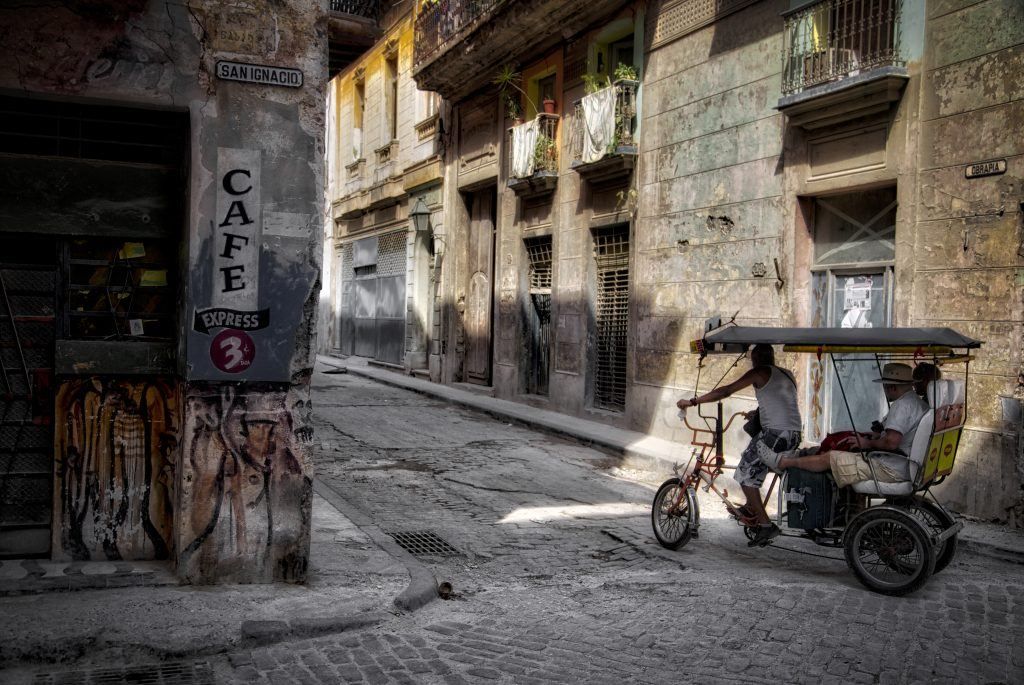
Hiring a three-wheel cycle rickshaw is a perfect way to negotiate the narrow, cobbled streets of the old city. In this example the HDR process really brings out the crumbling textures in the old, yet-to-be renovated section of Havana. Photo by Robin Nichols
2. General Photography – And Safety
In many countries, the quickest way for a photographer to fall foul of the authorities is to start taking pictures in public places – and I include parts of Sydney, Australia; many locations throughout the USA; the UK; Europe; and part of the Middle East in this list, but not in Cuba. In Cuba you’ll find only a few instances where you cannot take pictures. These include airports (same as in any country), some museums, government offices, cigar factories (curiously!), and photos of the police – which is a similar situation everywhere.
As with any arrival into a new destination, your first few days as a photographer might be a bit confusing – the light is usually quite intense, it’s hot, and the streets are narrow and, at times, quite crowded in the old quarter.
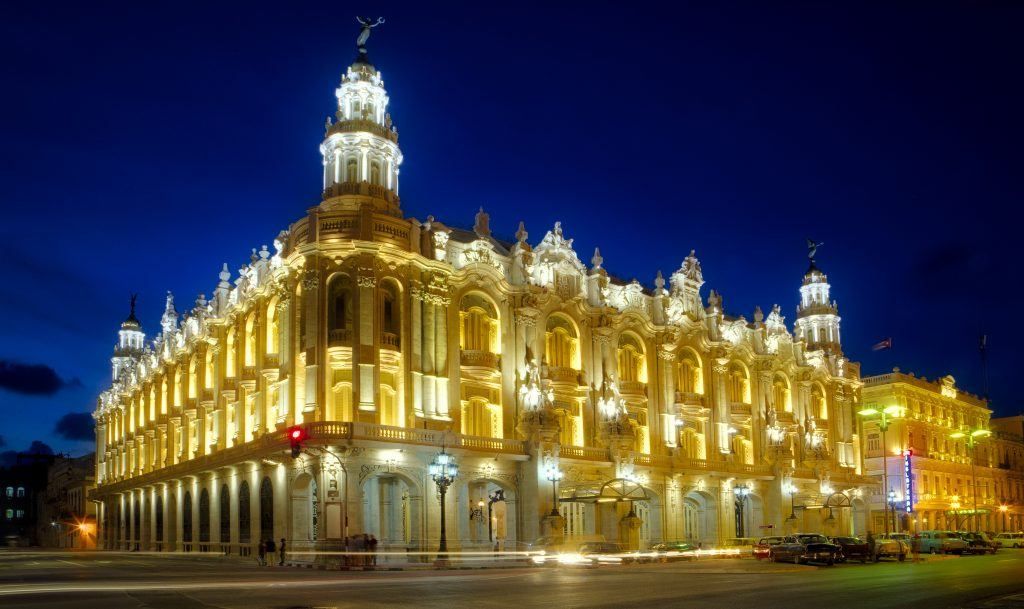
The area around Parc Central in central Havana is good for night shooting, especially if you set up a tripod for perfect stability during long exposures. Photo by Robin Nichols
Interestingly I found Havana, and Cuba in general, to be one of the safest countries I have traveled in, day or night. If you take the usual precautions – lock your valuables in the hotel safe, don’t tempt fate with overt displays of wealth, and be careful in crowds – you should enjoy a hassle-free trip.
Interestingly I found Havana, and Cuba in general, to be one of the safest countries I have traveled in, day or night.
On my first evening in Havana two of us set out with DSLRs and tripods to shoot in the streets around the Parc Central, diagonally opposite the imposing Capitolio building – a stately edifice which looks like the White House in DC, but bigger.
This is also where you can hire a restored pre-1959 American automobile, plus driver, for a drive along the Malecon and through parts of the city for an hour or so. It’s a great way to get your bearings, to see parts of Havana that you’d not normally experience, and to get some great-looking car shots in front of various notable monuments such as the Hotel Nacional, which was once host to U.S. gangsters like Meyer Lansky and Lucky Luciano.
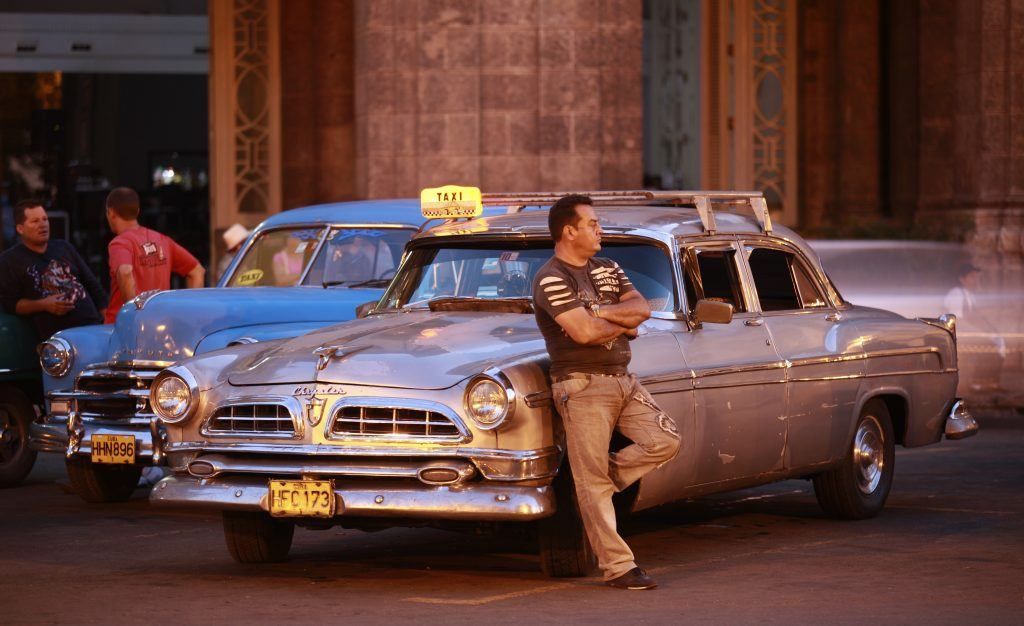
Shooting at night, even in a brightly lit location, requires a long exposure. In this example of a taxi driver and his Chrysler, it was a quarter of a second. You cannot hand-hold a long exposure like this so use a tripod where possible, rest the camera on something solid, or shoot with a monopod. Photo by Robin Nichols
We felt it was surprisingly safe to wander through and photograph, even when carrying gear worth more than a Cuban doctor could earn in 18 months. Of course, there are pickpockets and petty criminals in all major cities around the world so, even in Havana, care must be taken, but crime in Cuba is significantly lower than in many Western countries. Police are quite visible in all the tourist areas. It’s also worth appreciating that each urban district has its own neighborhood watch – official in the shape of a local ‘committee,’ and unofficial in the many locals that spend their days hanging out in the street. It’s not the Stasi, but the fact that Cubans enjoy a street culture means that it’s harder to commit a crime and not be seen.
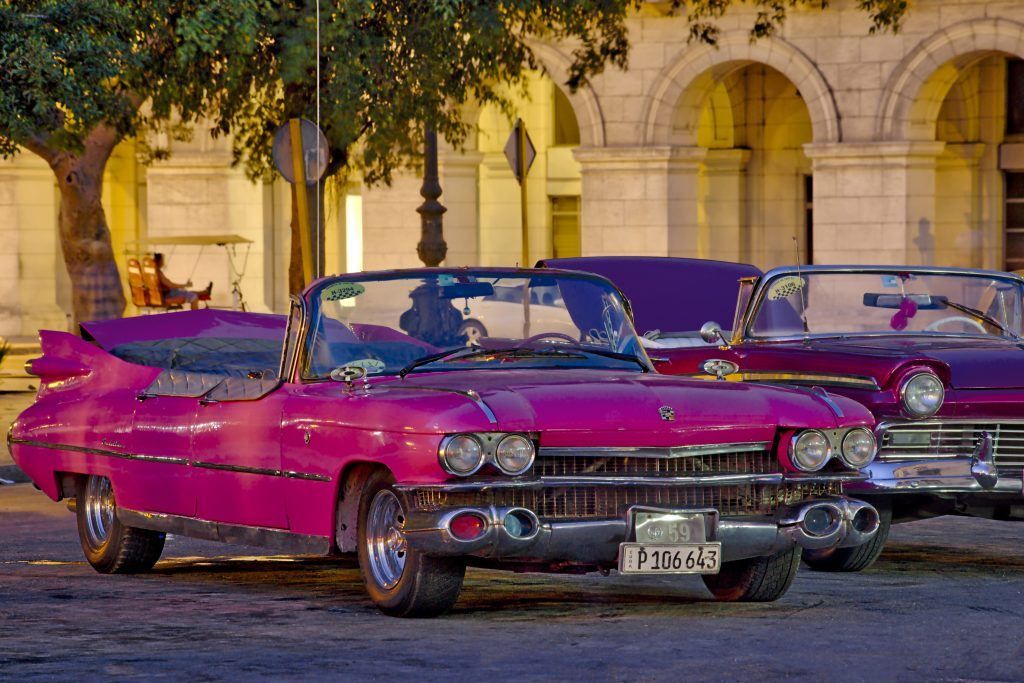
Shooting vehicles under artificial lighting in central Havana produced great, over-thetop color. You definitely need a tripod, and a bit of patience, waiting for a clear break in the pedestrian traffic to get the right result. Extra-long exposures also work (by setting the aperture to f11 or f16) because as the shutter speed becomes so long, people that walk through the shot while it is still exposing barely show up on the final result. Photo by Robin Nichols
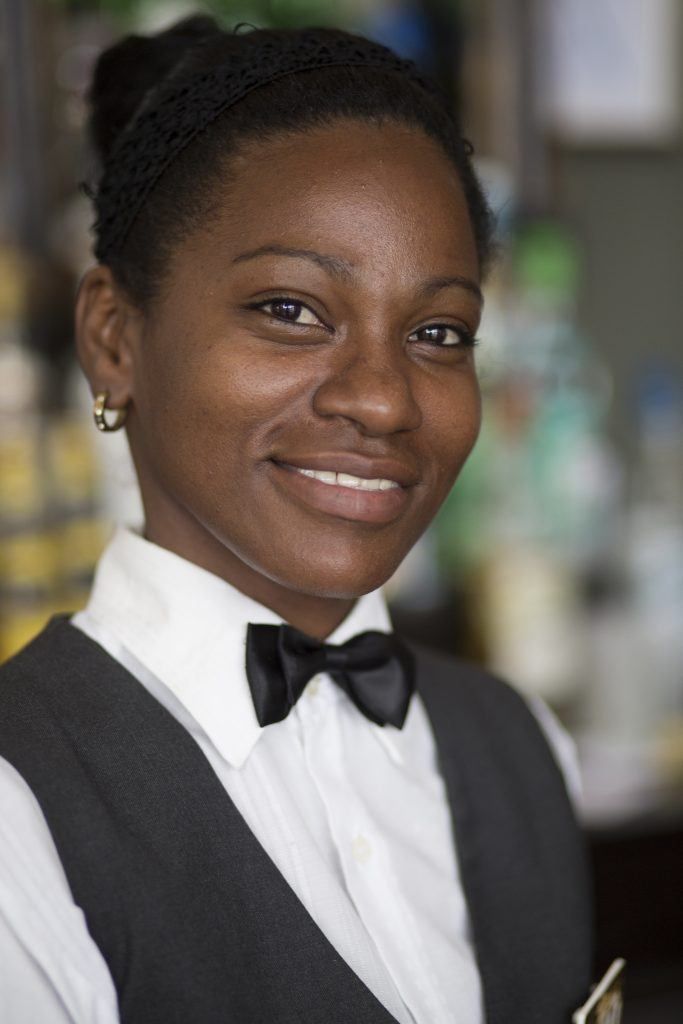
This is one of the bar staff from the somewhat infamous Hotel Nacional in Havana. She had such a beautiful smile. It always pays to be 100% ready with your exposure and lens settings before you approach a local so you can get the shot right away, and not interrupt whatever they were doing before you asked. Photo by Robin Nichols
3. General Gear Advice
When packing for Cuba, pack light. It’s a tropical country, so it experiences good temperatures year-round.
I’d recommend lightweight, natural fiber clothes and comfortable walking shoes (you might find the uneven cobblestone streets hard underfoot). I’d recommend taking a decent midrange zoom lens (i.e. a 24-105mm or 18- 135mm), maybe a wide-angle lens (i.e. a 17-35mm zoom), and a standard prime lens (i.e. 50mm f1.8, or maybe an 85mm f1.8, for portraits) along with a lightweight carbon-fiber tripod for night photography. You’ll have less need for a telephoto lens unless you are specifically joining one of the specialist bird-watching tours that operate in parts of Cuba.
If you are considering a new camera, going mirrorless might be a good idea. At about half the size and weight of a DSLR kit, and significantly less expensive, going mirrorless should be a no-brainer. My idea of a perfect travel camera would be a mirrorless camera with a pro 12-35mm f2.8 lens (24-70mm DSLR equivalent) and maybe a 12mm wide-angle and a 45mm prime (non-focusing) lens for portraits.
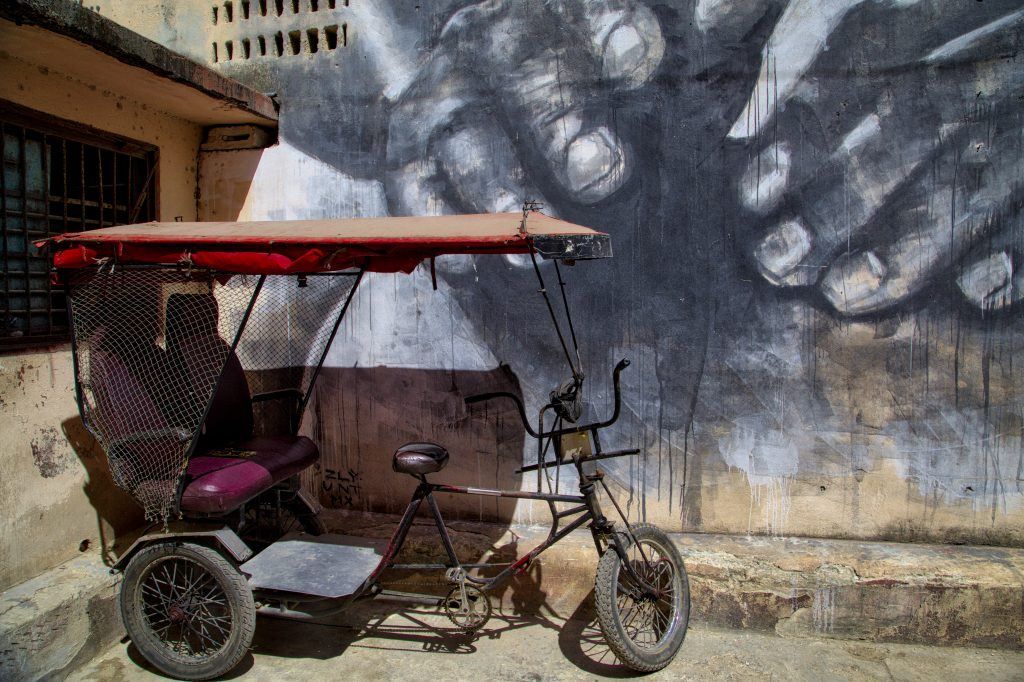
An abandoned cycle rickshaw taxi parked up against a Cuban mural in old Havana. Photo by Robin Nichols
Shopping in Cuba is largely restricted to cigars and alcohol. There are no big stores, no supermarkets, and certainly no camera shops, so bring your own spare memory cards, batteries, and the cabling that makes it all work. Also remember to bring electrical adaptors as only a couple of hotels that I know of in Havana have universal power points. Most sockets (when they work) are either the U.S. two-pin variety or the European two-pin model (flat pin versus round pin). You will not be able to buy or borrow an adaptor easily, so get online and either buy one of each or one of those international adaptors that does everything before you fly.
You will not be able to buy or borrow an adaptor easily, so get online and either buy one of each or one of those international adaptors that does everything before you fly.
Old Havana (La Habana Vieja), and the centers of smaller cities, are an absolute pleasure for a photographer to wander through, day or night. The air is filled with the sound of salsa, the rumble of big Chevrolet taxis, the clip-clop of horse-drawn carts, and the sight of the local people promenading their neighborhoods, chatting, going about their business, hanging their washing out, or fixing their cars in the cobbled streets. Street photographers will love this place.
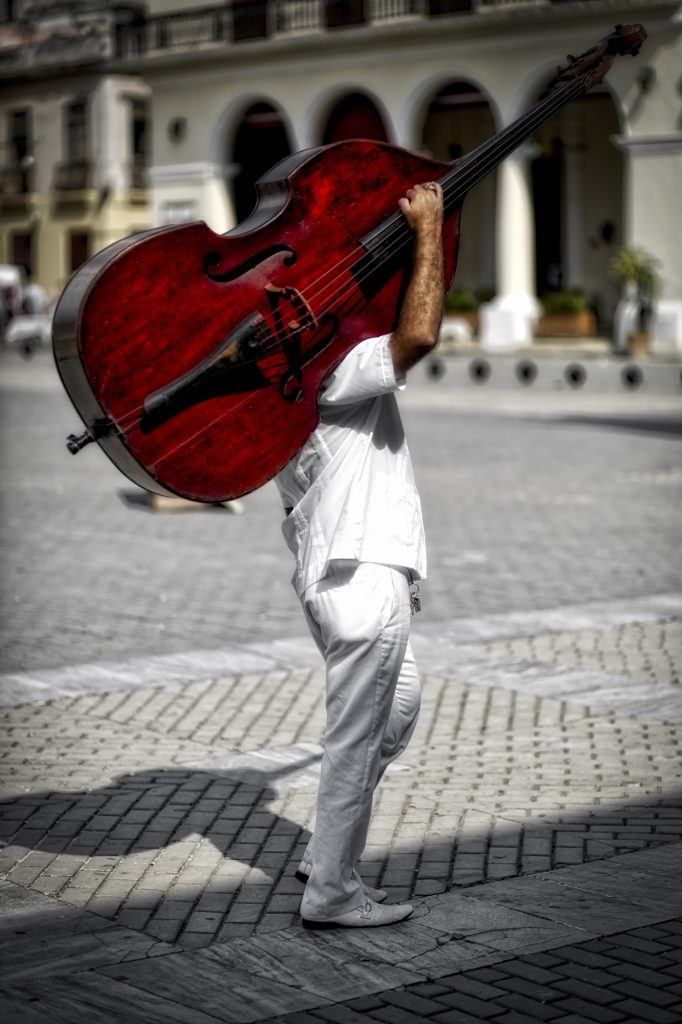
Music is part of everyday life in Cuba. This guy was heading off across the Old Plaza in central Havana to get to work. I saw him appear from a side street and had to run across the Plaza to get this shot. I subsequently processed the single RAW file in Aurora HDR Pro to add a dark vignette and richer textures. Photo by Robin Nichols
4. Photographing The Locals
Once you’ve had a couple of days to get over jetlag, consider lightening your camera bag by taking only one lens onto the street. I do this from time to time – pack an 85mm lens and go looking for people to snap. Of course, you have to physically approach potential subjects and ask them if it’s OK to take their picture (“…por favor, puedo tomar tu foto?”). The worst response you’ll get is a slight shake of the head if they don’t want to be bothered. On other days I just carry a wide-angle lens to shoot the wonderful old colonial architecture.
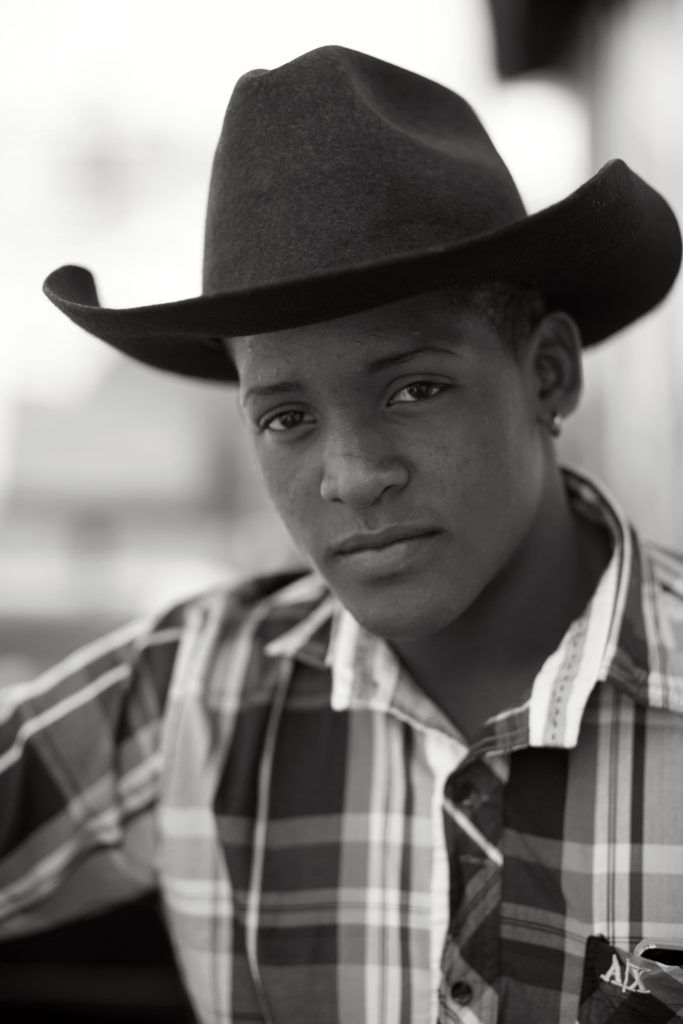
Always ask when you want to take a close-up portrait. Rarely do you get knocked back, but then you must be ready to get the shot without taking up their valuable time. Photo by Robin Nichols
I find that limiting your gear choices makes you work harder at composition, and usually produces more interesting results. If you are only in Havana for a day, that’s different, but usually tourists stay two or more days in each location so you have plenty of opportunity for great shots.
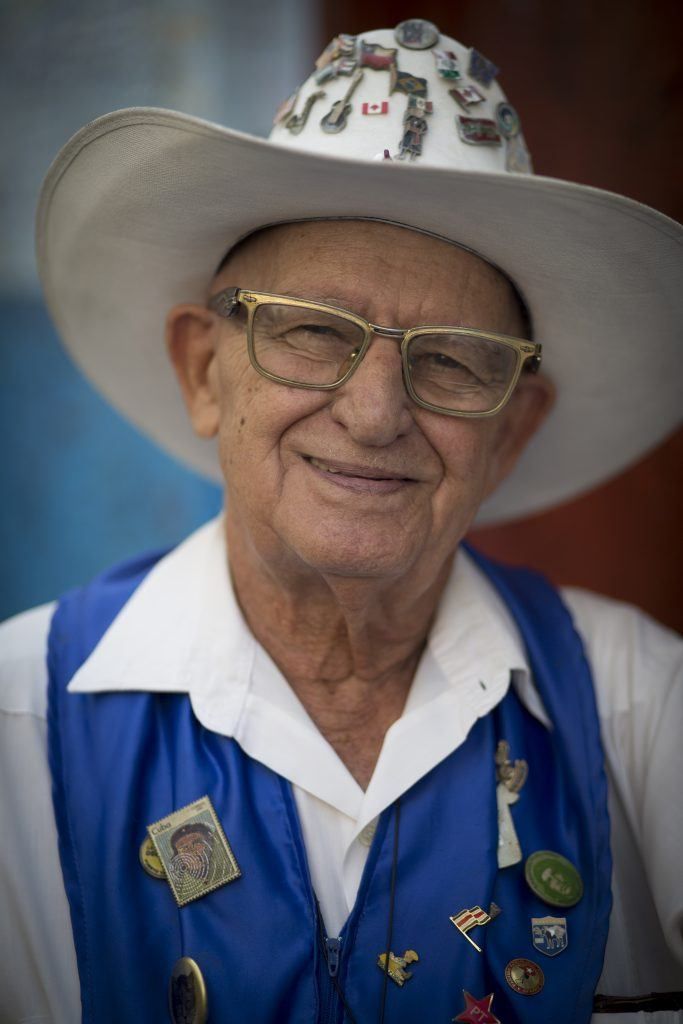
This man is one of many touts that frequent the tourist spots of Havana. He’s a story writer, and for a couple of dollars will write your story, in Spanish, on a certificate as a souvenir. Money well spent, I thought. Photo by Robin Nichols
You’ll certainly see a number of locals dressed up for the occasion – they definitely want to be photographed by a tourist because that’s their business, plus it’s possibly the only way they can supplement a very small state-provided income. Havana is peppered with folk dressed in their finest, clutching cigars the size of broom handles, just willing you to take their portrait. There’s an old guy that sits at a small crossroads in Trinidad with a chicken on his head and a man that rides around on his donkey for pictures for $0.50, plus a host of Santeria priestesses – ladies dressed entirely in white who’ll pose for a shot and tell your fortunes. Genuine or not, I really don’t have a problem boosting the local economy in this way.
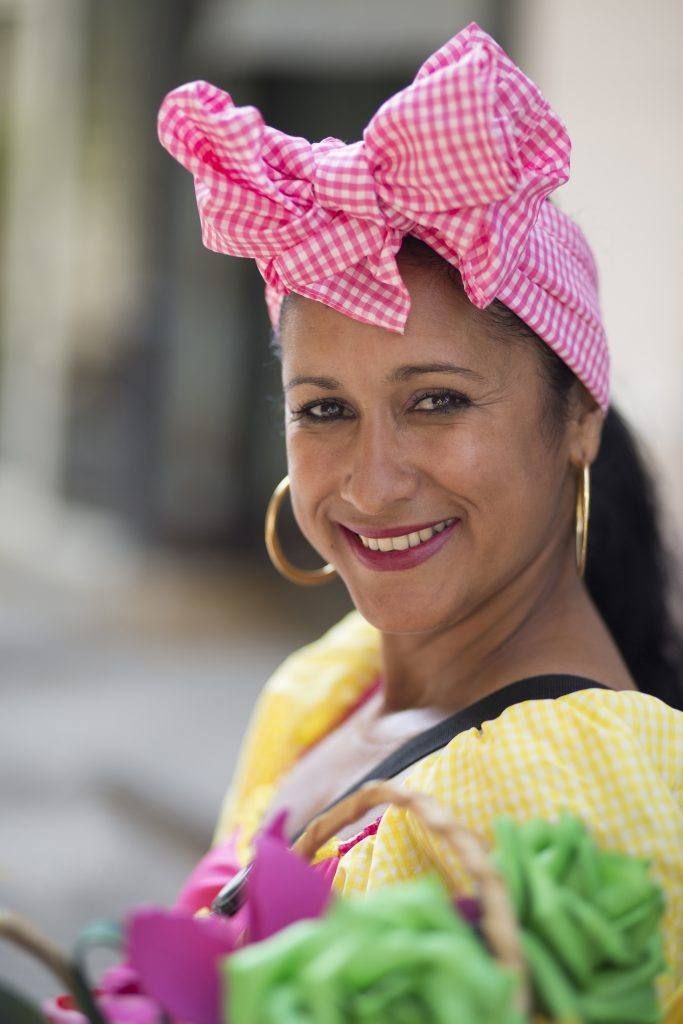
Another business-like Habanero, out selling flowers in the squares of Havana, poses for my 85mm lens. This short portrait lens has a wide, f1.8 maximum aperture and is therefore perfect for blurring out busy backgrounds. Photo by Robin Nichols
Recommended Reading: Want to improve your travel photographs? Grab a copy of Photzy’s bestselling premium guide, Powerful Imagery, by award-winning photographer Mitchell Kanashkevich.
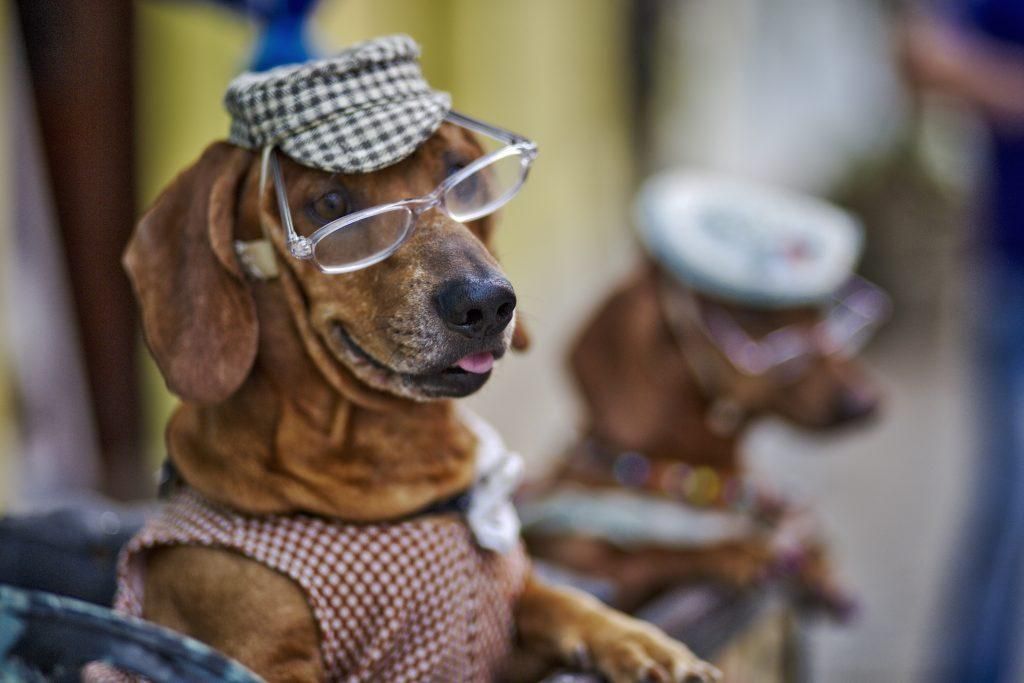
Apart from a man with a chicken on his head in Trinidad, this was the only other animal act I saw in Cuba. Another dollar spent and a slightly happier Habanero. Photo by Robin Nichols
Travel Tip - SCAMS TO AVOID
You will not miss the number of people that approach you trying to sell cigars on the cheap – actually, this is not so much a scam; rather it’s another Cuban way of doing business. The cigars could be genuine or they could also be pinched off the production line somewhere. If you are not into cigars, I’d say “non gracias senor” every time. And even if you are into buying cheap Cuban Cohiba cigars to sell back home, hopefully for a big profit, get them from a government-sanctioned retail outlet.
Another scam is run by touts trying to get you into a bar or restaurant. In reality it’s just another way to get commission on the drinks you buy. It’s not going to cost you a lot extra, but at the same time it’s annoying to feel that someone is trying to manipulate your decisions. Use your guide book to choose, ask the hotel concierge for a recommendation, or just wander the back streets until you find a place that advertises what you want – and always check your bill before paying for anything.
Other scams to look out for are taxis that overcharge in Euros and women that approach tourists begging for money to buy milk for their kids. Heart-rending, I know, but a scam nevertheless.
5. Media Backup
In case you have not already worked this out, Cuba is not the country to visit for fast internet connections. I’ve traveled extensively through this country and while I found connections in most of the larger cities, the speed and reliability provided is woeful, so you can rule out any possibility of backing up your photos to the cloud.
On my tours I try to persuade folk to bring a laptop – so I can teach them Lightroom, Photoshop, or bookmaking techniques while on the road – and of course, a computer is an excellent way to store or back up your work while traveling. Having a computer also means you get to see and edit your shots from day one, allowing you to pick up any potential shooting errors with focus, color, and sharpness before much time passes. If you manage to edit at least some of your holiday snaps during the trip, the task of getting it all done once back home will seem considerably less daunting.
I’d also highly recommend packing a one or two terabyte portable USB hard drive. They cost as little as $90, and can serve as a second-copy backup for your computer’s hard drive just to give you more peace of mind should the laptop develop a fault.
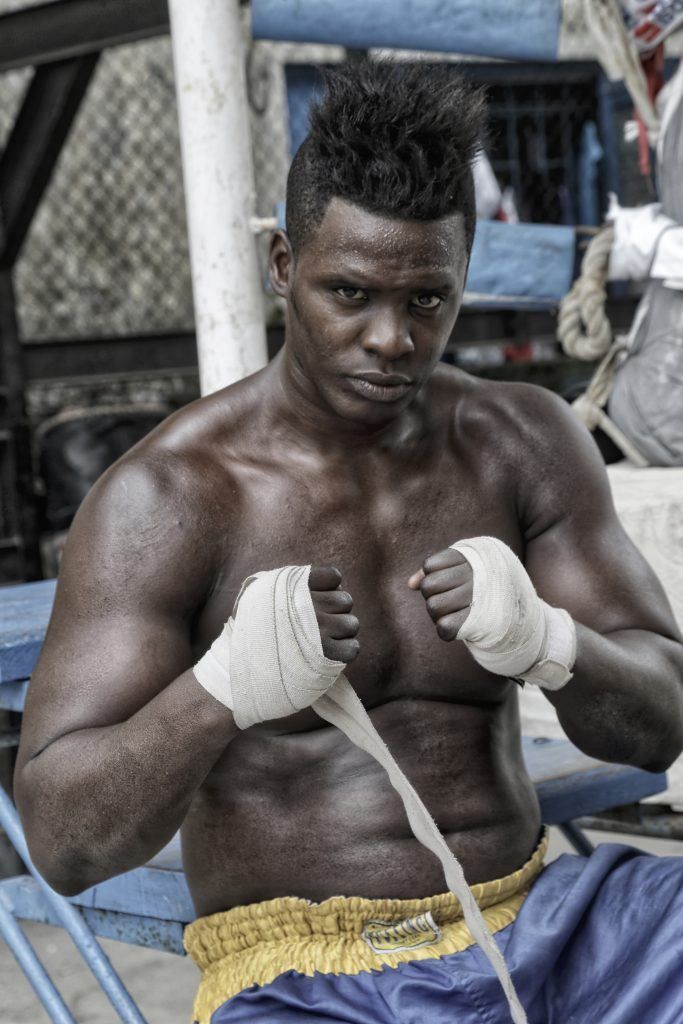
A good reason to travel with a laptop is that you can try different processing styles while still in the field. In this example I processed the portrait of a young boxer in a local ‘gimnasio’ in the back streets of Havana using HDR software to give it more ‘grit. Photo by Robin Nichols
6. Accessories
As already mentioned, it pays to travel light in Cuba partly because it’s much easier to keep an eye on all your kit. There are, however, a couple of accessories that I’d take. One would include a circular polarizing filter. These are available as a fixed-diameter glass filter to fit specific lenses, or an oversized filter that fits a universal holder, which can then be used across all different-sized lenses. I generally prefer to carry one fixed-size filter. You are most likely to use a polarizing filter on your mid-range zoom, so that’s the size I’d buy.
It pays to travel light in Cuba partly because it’s much easier to keep an eye on all your kit.
A polarizer is used to reduce reflection from shiny surfaces, such as water, but it might also work really well with foliage because that’s also very shiny, making green plants even greener by removing the reflection of the blue sky from the leaves.
Polarizers only work well when the sun is on your back and you are shooting at about 35 degrees to the horizontal; for example, when standing on a beach, looking out to sea around midday. At other times you might not get the same degree of color improvement. Note also that polarizing filters reduce your exposure by two f-stops of light, so avoid using them in low light, indoors, or in any situation where the shutter speed is critical for absolute sharpness.
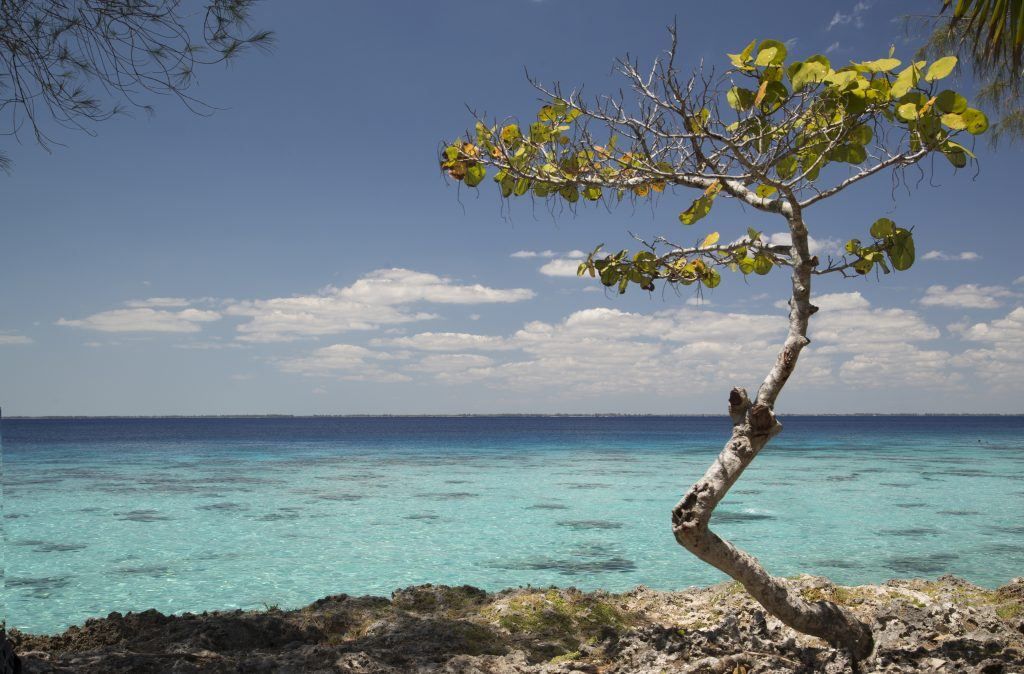
A polarizing filter will only produce an effective reduction in reflections in bright sunshine – and therefore stronger color in the ocean – as seen here in the Bay of Pigs. At any other time of day, a polarizer is less effective and, because it slows the shutter by two f-stops, is likely to produce a blurred result. Photo by Robin Nichols
7. Clean The Scene
As tourism in Cuba develops, so too does the amount of visitors. Last time I was there the numbers visiting the island had doubled since the previous year – many are just beach lovers flocking to the sandy keys dotted along the northern coastline, but even inland when you travel to towns like Trinidad, Santa Clara, and Cienfuegos, you’ll encounter quite a few foreigners.
If you prefer empty scenes in the cities, consider shooting for a Scene Cleaner process. This is an amazing post-processing software technique that only works if you remember to shoot the right frames while in the field. Let’s say you are in the town square in Trinidad – it’s busy and there are locals and tourists everywhere, making it difficult to get a clear shot of the classic old architecture. Set your tripod up with a clear view of the subject and shoot a picture. Wait until the people in the shot have moved to another part of the square and shoot another picture. Repeat this process a few more times. When ready, import the versions in Photoshop Elements and use its amazing Scene Cleaner utility to literally replace the people standing around the square with sections of empty space from the shots where they have moved on. Sounds crazy, but it really works, providing you shoot those sequences while in the field.
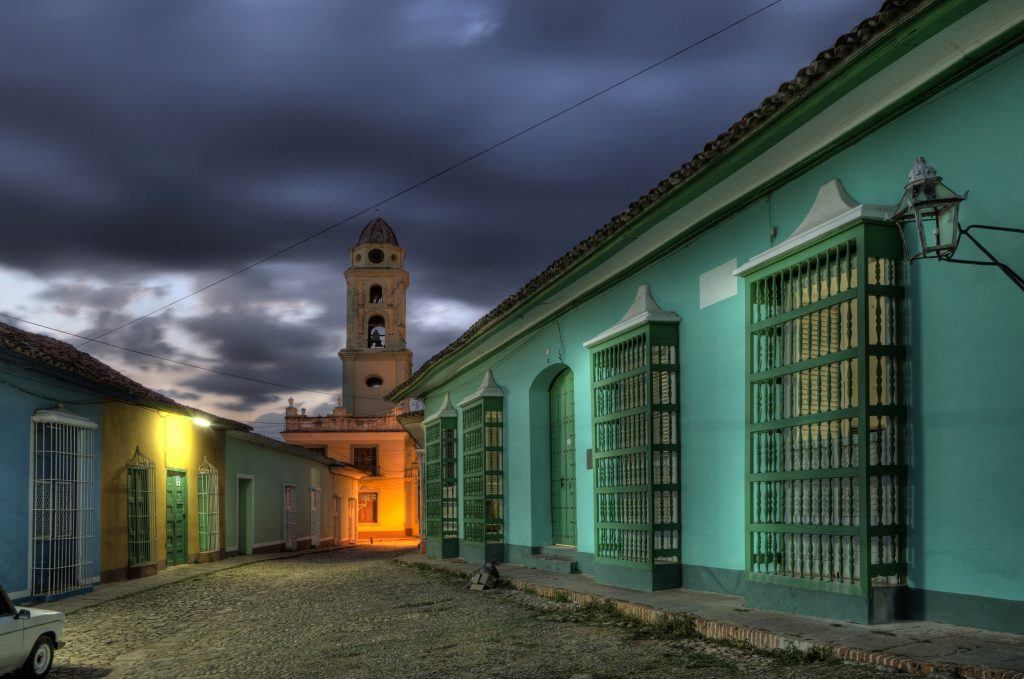
Trinidad, one of the most beautiful of Cuba’s many Spanish colonial towns, is always busy with tourists. I shot several frames on a tripod and then used Photoshop Elements’ Scene Cleaner utility to remove the people crowding ‘my’ scene to give this eerie, empty look to an otherwise busy spot. Photo by Robin Nichols
8. Shoot Panoramas
Another software post-processing tip that requires you to shoot components while in the field is for panoramas. Again, Cuba, like many destinations, has a great range of impressive sights that are large, widespread, or just too big for one shot. I recommend you then shoot two or more sections of the scene and use Elements, Photoshop, or Lightroom to stitch the lot together.
All that’s needed is for you to remember to overlap the frames by anything from 10 to 20 percent while shooting and keep the camera on the level. A tripod is good for this, but if you didn’t bring one, shoot a few panorama sections, handheld, and hopefully the software will help align the sections automatically.
Another tip includes taking a snap of your feet before and immediately after shooting sections of a panorama so that, months later when you are looking for those sections to stitch, they are easier to find – between your feet! If you have the time, shoot in manual metering mode (to keep the frames the same brightness) and set the auto focus (AF) to manual focus (MF) (and don’t forget to change it back afterwards) to avoid the lens re-focusing before you have finished shooting all the sections.
Don’t forget, this technique is not just for shooting big landscapes; use it to capture the size of the old squares of Havana, or overlooking the expanses of Guantanamo Bay, or even inside one of the country’s fabulous old cathedrals. The technique works almost as well indoors as it does out.
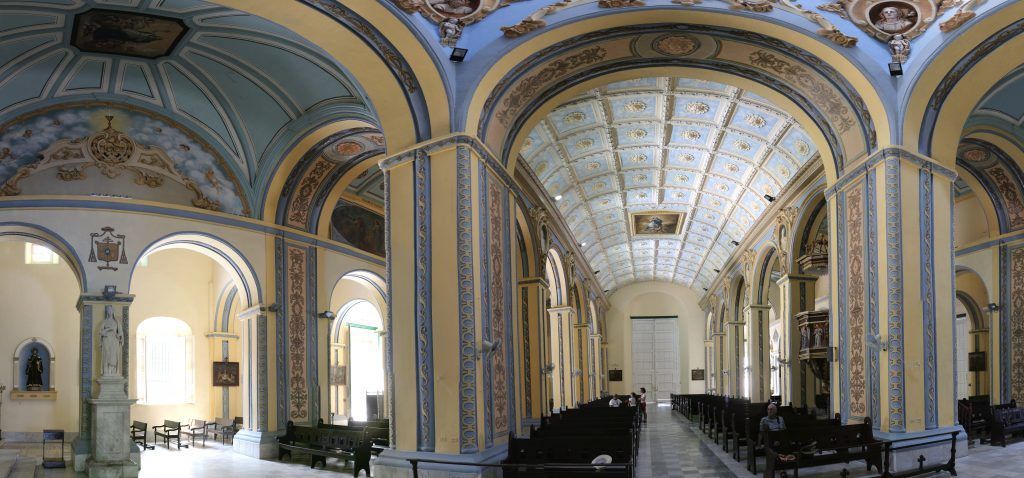
This is a four-section panorama, stitched using Photoshop Elements. It was taken inside the cathedral in Guantanamo City. Big interiors like this, are reasonably simple to shoot and stitch as panoramas, providing there’s enough light – and not too many people crowding the scene. Photo by Robin Nichols
9. Panning Those Amazing Automobiles
The cars. Even if you are not a car nut, you can’t not take pictures of Cuba’s beautiful classic automobiles. Because imports of almost everything stopped after the U.S. embargo, you’ll see an amazing range of old, pre-1959 automobiles, some in terrible patched-up condition, some looking as though they just rolled off the production line in Detroit. Hire one and go for a drive – it’s a great fun experience. Try standing on a busy corner in town, preferably in the shade, and in Aperture Mode choose an f-stop that produces a slower-than-safe shutter speed (i.e. to deliberately add blur). This is normally around 1/30s. If you do not move and take a snap of a car cruising past, chances are the car will be blurred – the shutter speed of 1/30s is not quick enough to freeze the car’s motion. However, if you move at the same speed as the car, panning, and snap in quick succession, chances are that in most of the shots the car will be relatively sharp while the background will be blurred.
Even if you are a car nut, you can't not take pictures of Cuba's beautiful classical automobiles.
Panning a subject like this is certainly a hit-and-miss technique. The speed of the subject, your shutter speed, and the lighting all contribute to the success or failure of the image. Start with these suggestions and see if you need to increase the shutter speed or slow it down. Choose brightly-colored cars and a drab background to make the subjects stand out more. Make sure that the subjects are passing parallel to your position so the focus distance does not change and confuse matters more.
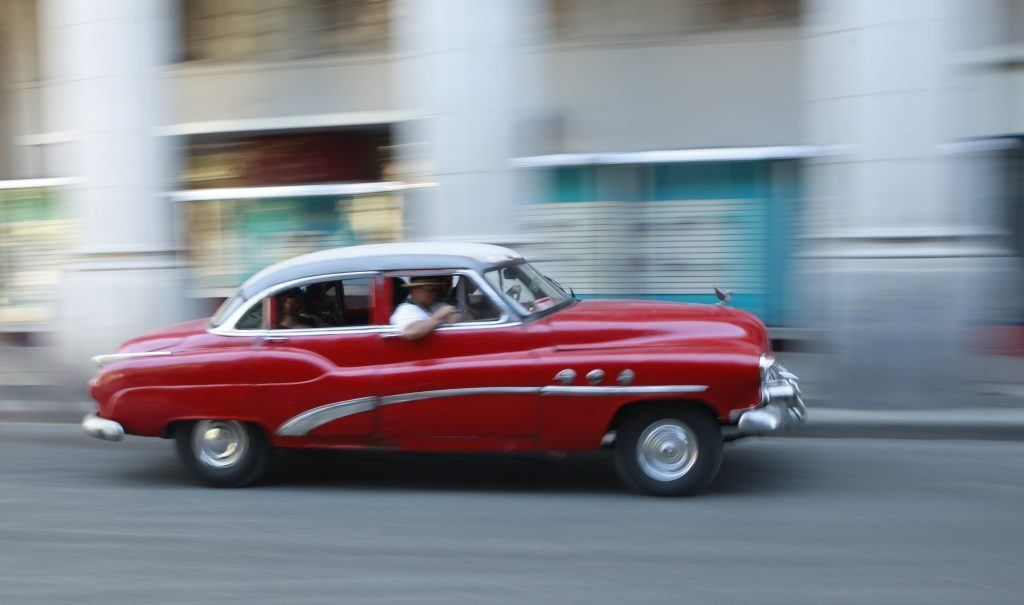
Even if you are not a car freak, it’s hard not to like these classic old automobiles from the USA. Adding a ‘panned’ look to the picture – deliberately shooting with a slower-than-normal shutter speed and moving in the same direction as the vehicle while you snap off images in high-speed drive mode – is a great way to emphasize motion while also blurring out the background details. Photo by Robin Nichols
10. Night Time
Many places in Cuba come alive at night time. The Cubans love music and you hear strains of ‘Guantanamera,’ ‘Chan Chan’ (from the Buena Vista Social Club), and the haunting ‘Habaname’ everywhere – in clubs, bars, cafes, and being played by lone guitarists sitting on a step somewhere – just because they like music.
I’d recommend visiting anywhere where music is played. Cuba has some great local night clubs, and a couple of the most famous include the Casa de la Trova in Trinidad and in Santiago de Cuba. These are small, noisy clubs that cost almost nothing to get into, provide a good range of drinks, and host local bands, singers, and performers. Other towns have similar venues. Not only is it a great place to hang out for an evening, but it’s also a good spot to shoot some of the locals doing what the locals do so well: sing and dance.
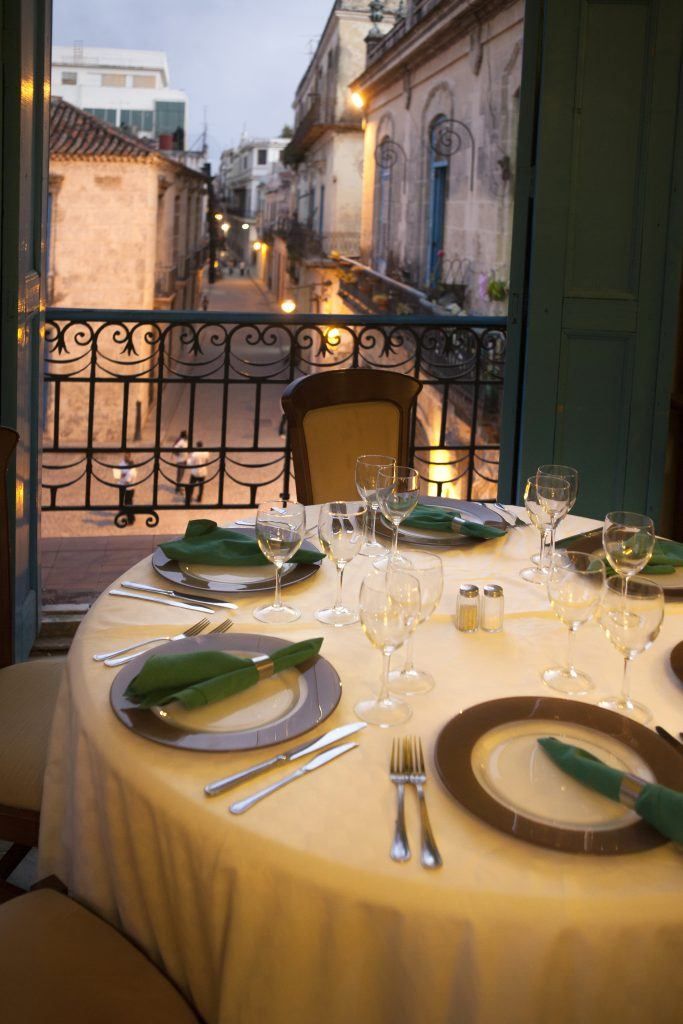
Although you’d never go to Cuba for the food, you can find an increasing number of innovative restaurants that produce excellent results. Here’s a restaurant shot I made for a group tour to the island in 2014. Photo by Robin Nichols
To get the best results you’ll preferably need to have a fast lens (f2.8 or faster), shoot handheld (there’s usually little enough room for people, let alone a tripod), and boost the camera’s ISO to the max to get good, shake-free results.
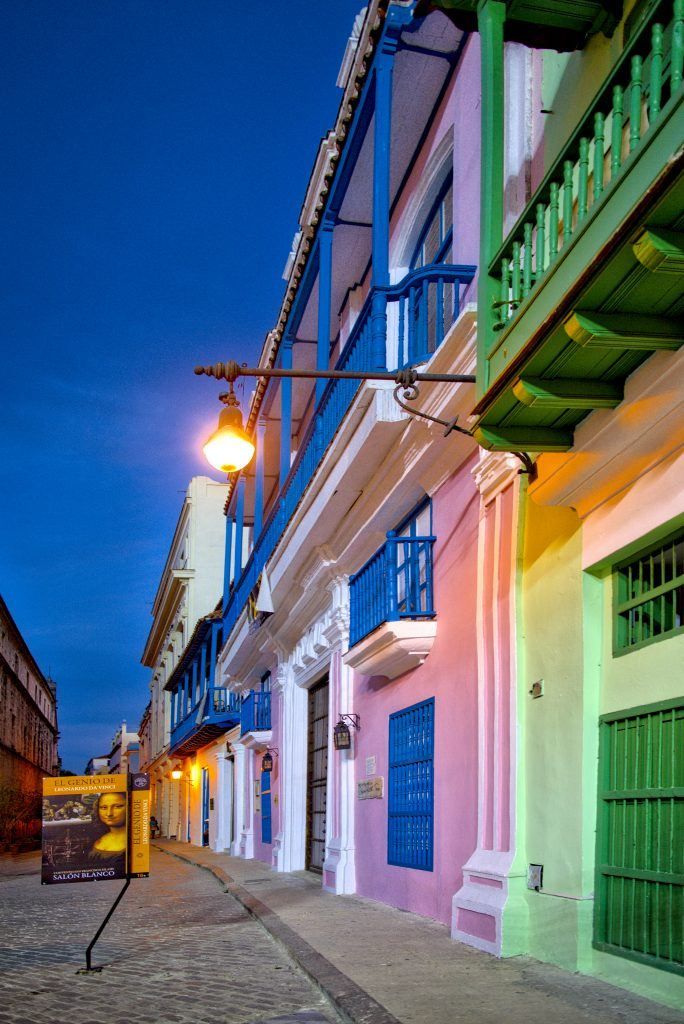
Evening is an excellent time to capture the best light and color. Mixing a bit of natural light with artificial illumination like this street scene in Havana can produce almost surreal color with little post-production needed. Photo by Robin Nichols
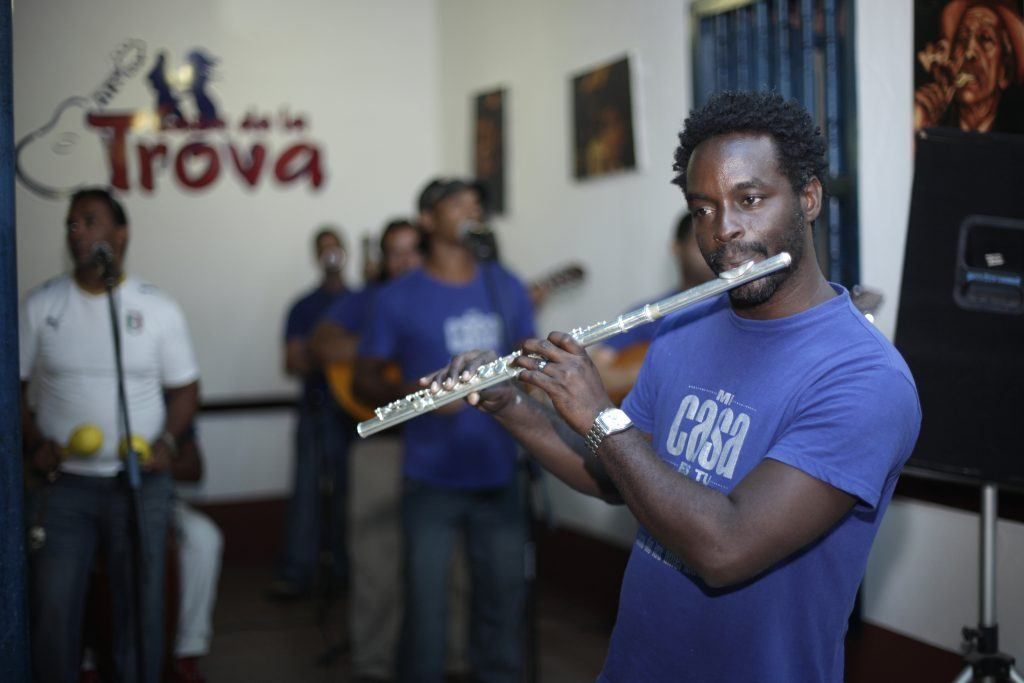
Music bars and night clubs are part of Cuban life and are great places to people watch, try dancing salsa, and take snaps of the local bands. A fast (f2.8) lens and high ISO will ensure you get clear, sharp results. Photo by Robin Nichols
If you are going out to a club, shoot at dusk on the way out – the best time of day, in my opinion. The light softens, colors take on that wonderful warm hue, and the shadows lengthen. Sunset gives you up to an hour’s worth of shooting and by the time it’s dark, you are ready to dine in one of the island’s famous private family-run paladars (restaurants) before hitting the dance floor in a music club.
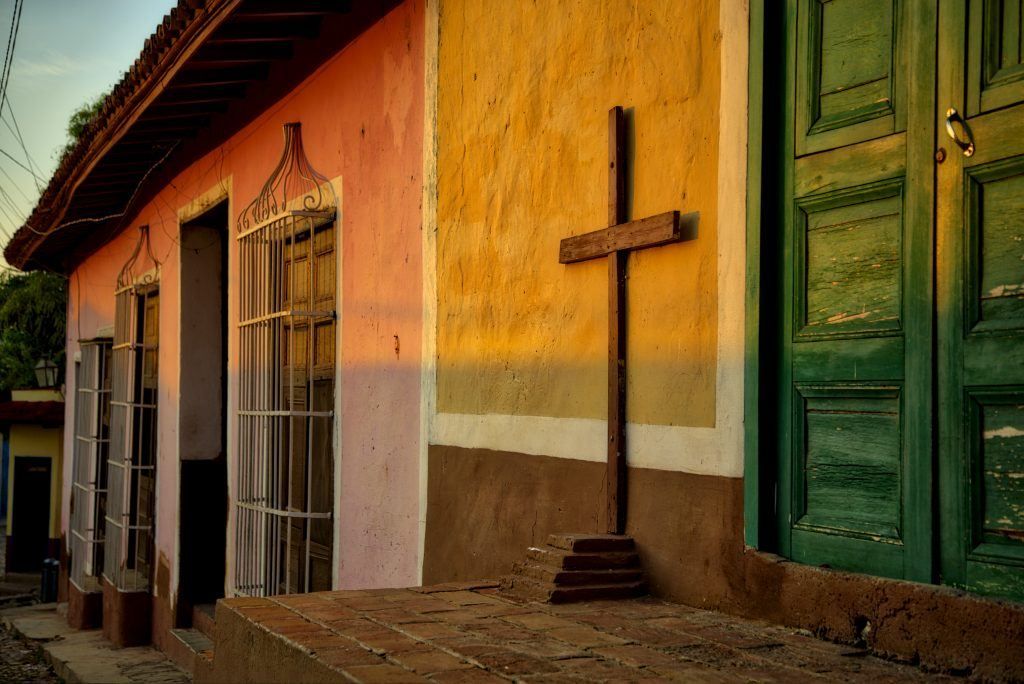
Walking is the best way to find interesting places, people, and good light. This image was snapped in Trinidad toward the end of the day with soft light and great, rich color
Recommended Reading: Want to improve your travel photographs? Grab a copy of Photzy’s bestselling premium guide, Powerful Imagery, by award-winning photographer Mitchell Kanashkevich.
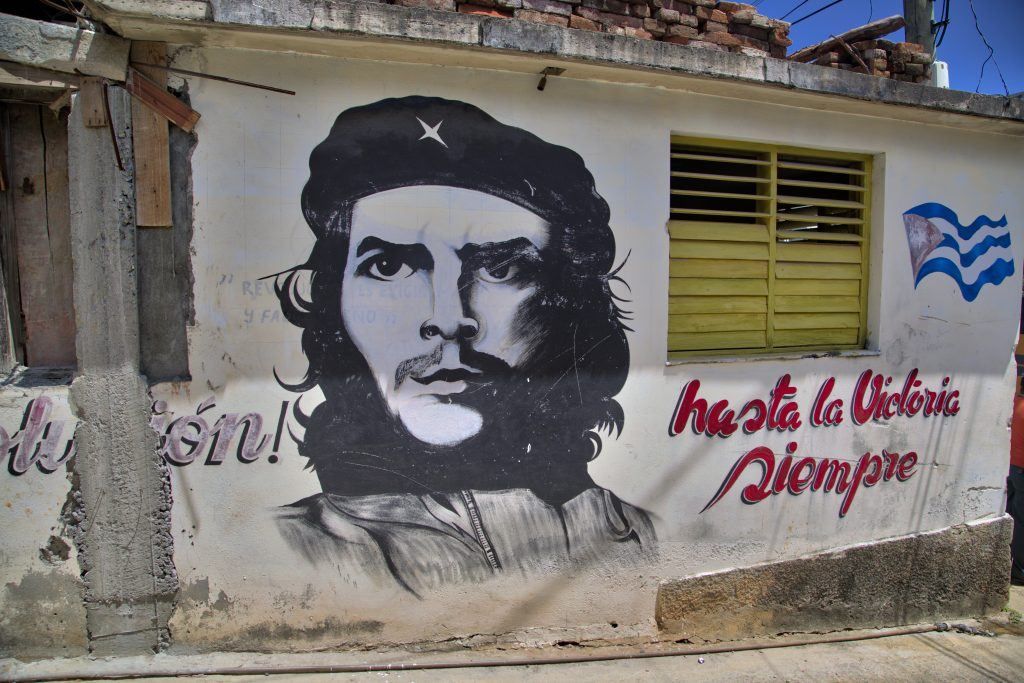
Hasta la Victoria siempre! (Until victory, Always!) This was a favorite catchphrase of Che Guevara, one of the Cuban Revolution’s most famous figures. His face still adorns t-shirts, posters, and murals all over Cuba. Photo by Robin Nichols


